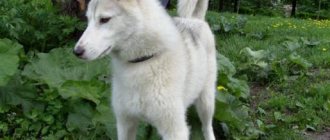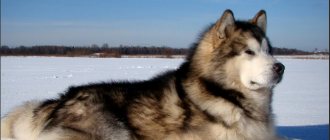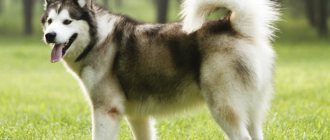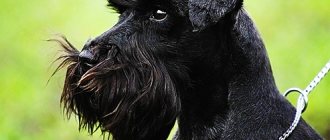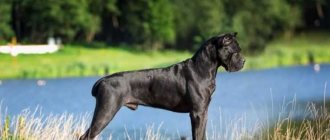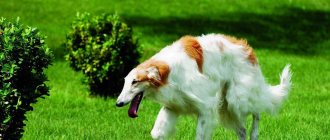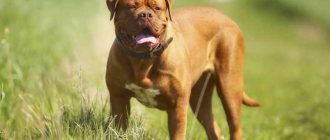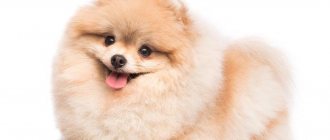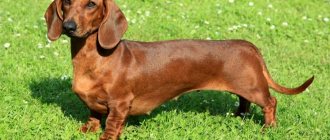History of the origin of the breed
One of the oldest dog breeds native to North America is the Alaskan Malamute. It can also be assumed that these dogs live side by side with humans longer than others; have been domesticated and tamed before. This fact is supported by the fact that DNA analysis showed their close relationship with wolves (domesticated wolves are recognized as their ancestors). About 14 thousand years ago, animals moved from Central and East Asia to North America, crossing the Bering Strait.
Interesting results were also obtained by comparing the DNA of Alaskan Malamutes, as well as Siberian Huskies and Alaskan Klickies. The results were impressive: if previously it was believed that these dogs are distinguished only by the presence of a common ancestor, but they are also related to each other. The main difference between the breeds is that Malamutes have heavier bones and are somewhat larger and heavier than their relatives.
The history of this breed began in the harsh conditions of the north, where they lived with the nomadic Eskimo peoples as full members of the tribe. Men often took them hunting; Animals also protected people’s homes and property. Over time, Malamutes also began to be used as sled dogs.
It was the difficult climate and difficult living conditions that played a fundamental role in the formation and development of the breed: evolution generously rewarded the animals with physical strength, endurance, and the ability to endure hardships. The species' range expanded over time, covering new territories, in particular the Anvik River basin.
Europeans managed to discover this breed towards the end of the 19th century. This phenomenon is explained by the fact that the Gold Rush began in 1896. And thousands of people, in pursuit of quick enrichment, rushed to the Klondike. Since difficult conditions made it necessary for visitors to quickly move around the area, and the main means of transportation was dog sleds, there was interest in animals well adapted to this. Malamutes met all the requirements for sled dogs; therefore, the demand for them grew. But prices for dogs of this breed have also increased significantly - one individual could cost at least $500; and for a team they could demand from one and a half thousand. Nevertheless, after a short time, Malamutes became the most sought after and expensive dogs in that area.
Over time, people who arrived in North America began to bring St. Bernards, as well as Newfoundlands, to the continent. In the hope of obtaining breeds with more developed strength qualities, they began to cross them with Malamutes. However, hopes were not justified. When dog sled racing gained popularity, there were also attempts to put animals in one team, however, this experiment also failed: the dogs could not work harmoniously, and skirmishes broke out between them all the time. But the Malamutes themselves turned out to be indispensable in this matter - for example, the famous All Alaska Sweepstakes race of 1908, where dogs had to cover a distance of 408 miles, significantly increased the prestige of the breed.
Crossing Malamutes with other dogs had another purpose. Although the stamina that later became the hallmark of this breed set them apart from other dogs, many other characteristics - such as endurance, as well as the ability to work in a team - were never their strong point. However, the activity aimed at obtaining a new breed also had a downside - for example, due to the active crossing of Alaskan Malamutes with dwarf dogs, it led to the fact that there were practically no purebred dogs left.
A group of breeders volunteered to prevent the final extinction of the animals, and for two decades they divided the breed into three basic lines: M'Loot, Hinvan-Irvine and Kotzebue. However, plans to revive the breed were disrupted by the Second World War. Once the dogs were involved in active combat, they suffered significant losses. And by 1947, there were no more than thirty individuals in the world. In order to prevent the extinction of the species, breeders had to look for a compromise solution and deviate somewhat from the breed standards.
Currently, the breed has not only managed to survive, but is also successfully developing and remains one of the most popular in the world. And today the dog, originally used as a sled dog, is still in demand in this field due to its phenomenal endurance and exceptional performance. And besides, it is one of the official symbols of Alaska.
Origin
Malamute, or Alaskan Malamute, is a breed of dog that was originally classified as a working dog. The birthplace of the breed is considered to be the far north, and more specifically, the coast of Alaska. According to one of the common versions, the ancestors of modern Malamutes were sled dogs of the Eskimo Malamute tribe that inhabited the shores of Alaska. Malamutes, along with huskies, were actively used for the development of Alaska (including during the Gold Rush) as sled and working dogs. During the Second World War, Malamutes were drafted into the army, which resulted in their almost complete extermination. Through the titanic efforts of breeders and by crossing the three remaining lines of these dogs with each other, the number of Malamutes was restored and significantly increased in the second half of the last century. At the moment, this is a very popular breed, a symbol of the State of Alaska.
Malamute breed standard
What is a Malamute? The description of the breed is as follows. The trait that distinguishes Malamutes - dogs of this breed - is developed muscles and large bones, because of which they are very similar in appearance to wolves. This is an exceptionally strong and at the same time agile sled dog. Despite her rather impressive build, she is quite compact; the animal's body is covered with thick and coarse hair; the undercoat is soft. Breed characteristics:
- The height at the withers of males ranges from 58 to 60 cm (for females) and from 60 to 64 cm (for males).
- The animal's head is large, but at the same time proportional to the body in size. The muzzle is also voluminous, but it is not elongated and does not have a pointed shape.
- The dog is distinguished by powerful jaws, large and sharp teeth, and a scissor bite. The lips are tightly closed.
- The animal's eyes are set slightly askew; they are almond-shaped and most often brown. Size is medium.
- The dog's triangular ears are elegant, erect, and slightly rounded at the ends. They are located far from each other.
- The nose is most often colored black; the only exception is the red Alaskan Malamute (their nose has a brown tint).
- The dog's strong, slightly arched neck gives it a special grace.
- The chest is quite wide. The back is straight, the lower back is strong and muscular. The tail, when at rest, rises above the animal's back.
- The Alaskan Malamute's coat is one of the animal's most distinctive features. Since this dog first inhabited the northern territory, it is moderately tough, but at the same time it has a rather soft fluffy undercoat and is a little oily (this feature should protect the dog from hypothermia and makes it waterproof). Long-haired Malamute.
- Smooth, parallel limbs in appearance slightly resemble bear paws. The bone is wide, the muscles are well developed.
- Acceptable coat color ranges from gray and sometimes bluish to white and black.
- The Malamute girl is different in that her first heat begins between eight months and a year.
Varieties
Today there are two main varieties of the breed - M'Lut and Kotzebue. Despite the fact that experts have not yet figured out which variety has the best qualities, each of them within the species has its own advantages and disadvantages.
And also, Canadian, Caucasian, English, American, and Siberian Malamutes can be classified into a separate category. Each line has its own characteristics. For example, Canadian dogs are characterized by extremely low aggressiveness, while Asian (in particular Siberian) dogs demonstrate high affection for children. The physically strongest malamutes live in Yakutsk; Altai has become home to the largest individuals of this breed.
M'Luth
Size and weight
Considering how much an adult dog should weigh, we note that the body weight of the animal as a whole depends on gender: the standard norm for females is 34 kg, while for males it is slightly larger and amounts to 38 kg. The average height of a male is 63–64 cm, a female is 58–59 cm.
Color and coat type
The nature of coat color is influenced primarily by the characteristics of the intrabreed line. For example, the M'Lut line has colors such as black and white, brown and white, white and red, and even blue. The Kotzebue line has a gray “wolf” color.
Kotzebue
Health and illness
The harsh northern climate had a beneficial effect on the animal's health. But the Alaskan Malamute is characterized by two of the most common genetic diseases. They need to be detected before the puppy is born; This is why it is much more important to purchase animals from professional breeders.
- "Snow Nose" With this disorder, the animal experiences a disruption of nasal pigmentation; and instead of the usual black pigmentation, it is characterized by pink. With this disease, it is extremely undesirable for an animal to stay under the sun for a long time; he has a high sensitivity to ultraviolet radiation. Such a disorder, in principle, can be treated - for this purpose, the dog is given a special tattoo. However, breeders take such individuals under special control in order to subsequently prevent their crossing and further transmission of the gene responsible for the transmission of the disease.
- Chondrodysplasia is a disease that manifests itself in impaired development of cartilage tissue. And if the animal does not receive timely treatment and the owner does not take measures to eliminate the consequences of the disease, it will first lose the ability to run, and then to walk altogether. Symptoms of this disease begin to appear gradually, but increasingly. These include increased fatigue after physical exertion, and then he is reluctant to participate in outdoor games with other dogs and children. In later stages, the dog becomes lethargic and spends most of the time lying with its limbs outstretched.
In rare cases, Alaskan Malamutes may also develop polyneuropathy, hemophilia, diabetes, some eye diseases (glaucoma, cataracts, hemeralogia), and some skin diseases (demodex, atopic dermatitis).
Lifespan
How long do Malamutes live? Quite a long time by animal standards - on average, dogs of this breed can live from 12 to 15 years.
Peculiarities of shedding of the Alaskan Malamute
The Alaskan Malamute sheds in spring and autumn. Malamutes have an abundant undercoat and therefore during the molting period they need to be brushed 2 times more often than usual. If the pet is in a very warm room, the molting period may be delayed. They produce a lot of wool, so it is better to refrain from keeping them in the house.
Characteristics of the Malamute breed
When deciding to get a Malamute, you must remember that although representatives of this breed are not alien to such qualities as devotion and affection for their owner, reciprocity on the part of the owner is extremely important for them. And if a person has to offend the animal with something, to cause offense, this threatens a complete loss of trust and “switching” attention to someone else, in addition, the dog is tired of daily repetitive actions, from which he gets tired and can even be regarded as disrespect for himself . All this can significantly harm a person’s authority.
And also a distinctive feature of the Malamute is its need for a pack or family - it needs to live among people or animals. He is extremely uncomfortable in enclosed spaces; This is why keeping an Alaskan Malamute in an enclosure is impossible. Being alone for a long time, the dog becomes closed and withdrawn.
Attitude towards children and others
Most Malamutes are friendly and friendly animals. In addition, they love attention to themselves. This is what makes dogs of this breed absolutely irreplaceable in large families, where they happily take on the role of four-legged nannies, playing with children and looking after them when their parents are not around. However, it is still undesirable to leave them alone with children: the impressive size of the dog can frighten the child, and the animal can inadvertently touch or push him.
Dogs are also very friendly towards strangers. They are capable of showing aggression towards strangers only in cases where their behavior poses a real threat to the owner or his family. Therefore, guests should not be afraid of Malamutes. Even with their impressive size, they are very calm and peaceful.
Character of the Alaskan Malamute
The description of the Alaskan Malamute will prove that this particular breed is suitable for a large and friendly family. Dogs of this breed are very docile. They are kind to children. They can even play the role of a nanny. They will always be happy to take part in noisy games. They will definitely never hurt kids. They are loyal and sometimes even friendly with other pets. Especially if we grew up together.
Just look at their photos to appreciate the beauty, grace and strength of this northern breed.
Alaskan Malamutes have a different personality from other dogs. They do not become very attached to their owner. If the owner offends, the dog from Alaska is capable of falling in love with another family member. The Alaskan Malamute is a very boring creature. He cannot stand loneliness. It is not recommended to leave him alone at home for a long time. The dog is prone to howling, which can disturb neighbors.
Aviary “apartments” are not for this breed. A closed enclosure can upset a pet's psyche. He will become aggressive, distrustful and withdrawn.
It is recommended to bring your Alaskan four-legged friend into a private home with a spacious but tightly fenced area. After all, such a “northern handsome man” needs to run and play in the open air.
Dogs of this breed tend to dig, it is in their blood. All gardeners and gardeners, lovers of beds and flowers need to be prepared for this.
The character of the Alaskan Malamute is very stubborn and you need to train your four-legged friend every day. In this regard, it is not recommended for inexperienced owners to own this breed. If raised incorrectly, a dog's character can be ruined forever.
This breed has no protective qualities. It is better to look for another breed as a guard dog. The Alaskan Malamute is not capable of guarding its territory from strangers, as it loves everyone. He will happily greet guests, wagging his tail cheerfully.
However, not all so simple. If for some reason the dog’s psyche was disturbed during puppyhood, then this puppy can grow into an uncontrollable and aggressive dog. Only regular education, early socialization, competent training and immeasurable human love can form an obedient and affectionate friend from distant Alaska.
Training an Alaskan Malamute is not easy. After all, by their nature they are stubborn creatures that require an individual approach. They remember commands poorly and are lazy to carry them out. It's all about the mindset, these dogs remember their main purpose - to be a sled dog. With the blood of their mother, they have absorbed the instinct to live in the name of man, and not to serve him as a toy.
From the first days in a new home, puppies should know what is allowed and what is not allowed. The most important thing is that the owner does not give up. The pet may pick up on this and in the future it will be difficult to force him to obey.
Training and education
Malamutes are quite trainable and easy to train - even despite all their stubbornness. Thanks to their well-developed memory and curiosity, they are quite capable of easily remembering and assimilating commands. However, as we indicated above, they really do not like monotonous repetitive actions and therefore will execute the proposed command once at most twice. Therefore, if the owner notices that the dog has become irritable, angry, and refuses to follow commands, he definitely needs to be given a break. And only after that resume training.
In general, for successful dog training, it is necessary for the owner to comply with three important conditions:
- Start training from the moment the puppy arrives at its new home. This will minimize manifestations of stubbornness.
- Be persistent. The Alaskan Malamute dog is far from being one of those dogs that will easily trust a person and recognize his authority. And if at the right moment a person does not show strength of character and leadership qualities to the pet, it will be extremely difficult to achieve anything from him.
- Smart control. The Malamute breed is stubborn and persistent. If not properly controlled, there is a risk that these qualities may develop into more serious behavioral problems in the future; Simply put, the dog can become completely uncontrollable. It is important to stop any violation of the rules of behavior by the dog.
Features of character and behavior
- Malamutes do not tolerate loneliness and isolation at all. Therefore, it is better not to keep them on a chain or in an enclosure, otherwise the dog may get bored and harbor a grudge against its owner.
- By nature, Malamutes are quite stubborn and have high intelligence. Therefore, without proper upbringing, a dog may cease to respect its owner and become attached to other people.
- They can also get tired of monotonous actions . You should not force your Malamute to fetch the stick too many times; he may feel that he is being treated with disrespect.
- Malamutes are very difficult to train and are very stubborn . But thanks to their high intelligence and good memory, they remember all commands very well.
If an animal is poorly raised, psychologically traumatized (especially to a puppy), or simply treated cruelly, then this harmless and friendly animal can become evil forever.
Advantages
Among the advantages it is worth noting:
- Friendliness and sociability;
- Mind;
- Easy to care for;
- Silence (barks only when absolutely necessary).
Flaws
The Alaskan Malamute has many disadvantages:
- Very stubborn. This breed is quite difficult to raise because they do not like to be obeyed;
- They do not like repeated repetition of monotonous actions;
- A bad guard, despite his impressive external qualities. This is explained by excessive kindness towards absolutely all people;
- The need for constant and heavy load;
- She loses a lot of fur during the shedding season.
Pros and cons of the breed
Stubbornness and incredible endurance - these qualities can be parallel to both the advantages and disadvantages of the breed. Why?
Fans of outdoor activities will certainly appreciate the character of the Malamute, namely the animal’s desire to always be close to its owner and good mutual understanding. And the love of long walks will be useful for hikers, who will be able to calmly take them with them, without fear of leaving them without attention and care for a long time.
But this breed is not without its disadvantages.
- First of all, it should be noted that with its impressive dimensions, impressive physical strength and endurance, consider this dog as a guard dog. The reason lies mainly in the fact that representatives of this breed are extremely non-aggressive, and their friendliness and kindness are unlikely to allow them to instill fear in people.
- The stubbornness of Alaskan Malamutes, due to which, if approached incorrectly, the dog can completely lose interest in learning and training. That is why it is best for fairly experienced dog breeders to interact with this dog.
- In rare cases, the owner’s incorrect behavior strategy, or severe trauma suffered by the animal at an early age, can lead to the puppy growing up to be a completely uncontrollable and aggressive animal. That is why breeders strongly do not recommend cultivating such qualities in an animal: the animal’s anger will be directed more at them than at strangers. If such manifestations are observed on his part, they need to be stopped immediately or seek help from specialists.
Maintenance, care and nutrition
The Alaskan Malamute breed feels extremely uncomfortable in a confined space. That is why the conditions of ordinary apartments will not suit her. The need for fresh air and walks will be satisfied if she lives either in a country house or in a spacious enclosure. Another negative aspect of keeping a Malamute in an apartment is that the dog needs to constantly grind down its claws and dig for something. If the hard floor of the apartment does not allow her to do this, the furniture may come under attack.
By the way, thanks to the thick coat, you don’t have to worry about the dog’s health even in low temperatures. In winter, dogs will be protected from hypothermia, but in summer they prefer to stay in the shade as they are at risk of heatstroke.
Care
Caring for and maintaining an animal includes the following components.
- Bathing. Malamutes love to swim in open water. In the warm season, especially in summer, this will be the best protection against heat stroke and overheating. However, you cannot limit yourself to them. And planned water procedures should appear in the animal’s life from a very early age. It is necessary to bathe animals once every three months using special shampoos for dogs. Exhibition specimens require special attention, in particular two-color ones. They need to be bathed using a product designed for white fur, which gets dirty more easily. And for colored ones - to emphasize the depth of the shade. A consultation at a pet store will provide more accurate information on the choice of products.
- Drying the coat after bathing using a special brush and hair dryer is also mandatory. Violation of this condition leads to the fact that the wool will roll up and look unkempt. Moreover, it is important to thoroughly comb not only the coat, but also the undercoat.
- You need to take care of your claws, ears and teeth carefully: be sure to clean them with hydrogen peroxide (once a week), brush them with a special paste and brush. The dog grinds its claws down on its own, but if they grow long and start to get in the way, they need to be trimmed.
- Frequent and intense shedding is another problem that Malamute owners have to face. During such periods, it is necessary to comb the animal’s undercoat every day. Failure to comply with this condition leads to the formation of lumps in the wool and to the fact that it will litter the entire floor in the house.
Diet
What to feed your Malamute? It is optimal if the Malamute eats natural food. Most often, a special mixture of cereals, previously cooked in meat broth, is prepared for such animals. Additionally, beef trimmings or tripe are added to it. If the owner plans to include dry food in his dog’s diet, its quality must be high - despite the fact that Malamutes are in good health, the risk of allergies still exists.
Before exhibitions, as well as during intense exercise, high-protein foods will help maintain your dog’s health.
Since dogs of this breed lead an active lifestyle, which protects them from the risk of obesity, there are foods that should not be included in the diet. Thus, feeding your dog potatoes, smoked meats, confectionery, and spicy foods is unacceptable.
